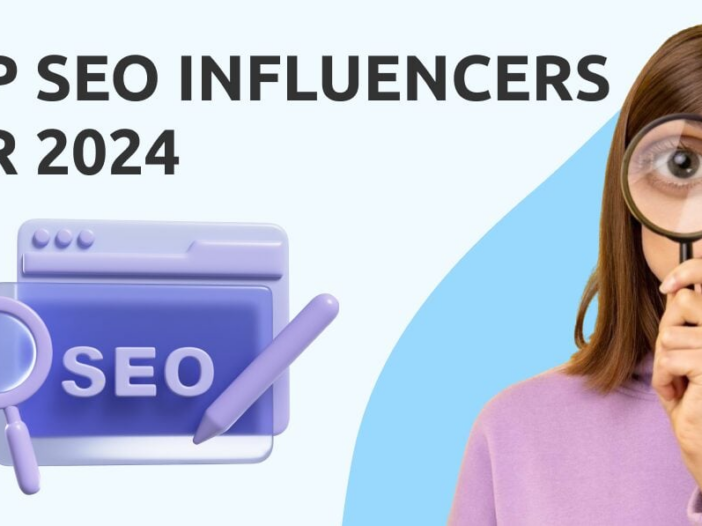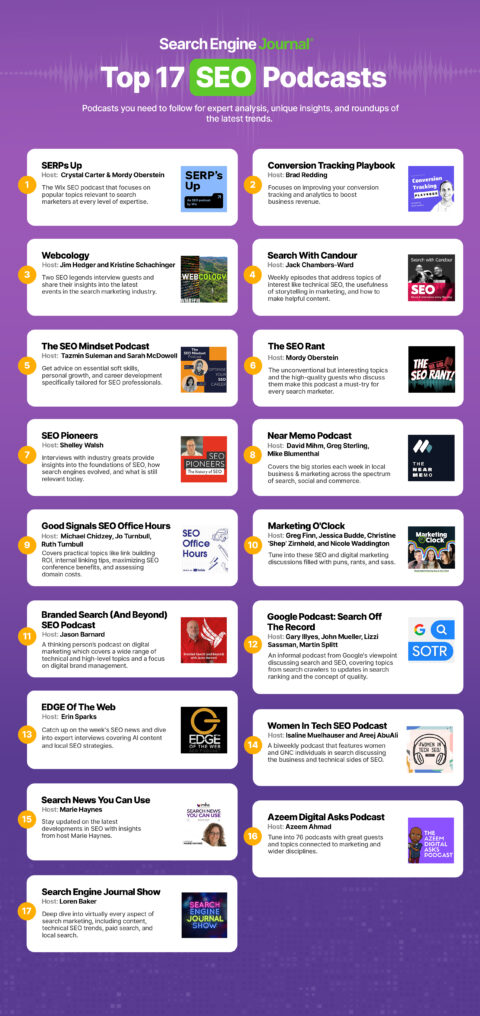You are here: Influencer Marketing Hub » Influencer Marketing »
In a world where 81.8% of the global internet user population has used a search engine at least once in the past 30 days, it’s no surprise that search engine optimization (SEO) is such a talked-about subject in the digital marketing space. Marketers not only want to learn about SEO but also how they can implement new techniques to rank higher on search engine results pages (SERPs).
Unless you’re specialized in the field or have been keeping up with the SEO industry for years, it can be hard to keep track of the latest trends and techniques. Recently, TikTok’s SEO Creator incentives program has made waves, offering monetization for content aligned with popular search terms, which is reshaping how influencers and agencies approach SEO strategies on the platform. But you know who always seems to be up-to-date with the dynamic landscape of SEO? SEO Influencers.
These influencers may be SEO specialists, digital marketing experts, content creators, or even business owners. They are present across a range of platforms from X to LinkedIn. Some run their own blogs, where they share their SEO knowledge extensively. We’ve found some of the best SEO influencers that you can learn from, so let’s dive in.
Like any influencer, an SEO influencer is someone who influences your understanding of a particular field. They are the go-to people for tips, tricks, and insider knowledge about SEO.
These influencers not only provide education on best practices, but some are also well-connected with individuals who shape the algorithms that drive search engines, giving them an edge in predicting and understanding upcoming changes.
Businesses or SEO specialists get the most benefit from SEO influencers since these individuals are walking and talking libraries of SEO knowledge. For example, a business owner can learn how to update their website in accordance with a recent Google update through an SEO influencer’s blog post or podcast. Similarly, SEO specialists can take insights and tips from these experts to incorporate into their clients’ strategies for the best results.
Usually, if you had to find an influencer, you’d use influencer marketplaces to identify the right fit based on their niche and audience demographics. With SEO influencers, the discovery process is a bit different. These influencers usually have their own websites or blogs where you can find them most active.
One of the first places to look for SEO influencers is LinkedIn. If you regularly engage with SEO-related content, LinkedIn will automatically suggest relevant profiles for you to connect with. You can also join related groups or follow hashtags like #SEO to find thought leaders in the space.
The same goes for X, which is another platform where SEO influencers have a presence. Again, search for relevant hashtags to find posts from experts or follow them directly to see their content on your timeline.
It was such a pleasure to have this little #SEO chat with @g33konaut and ask a lot of the questions about content that my clients have asked me over the years.
Thanks for having me, Martin and @googlewmc!
Hope you enjoy the video 😍 https://t.co/1jeWf5VVEa
— Lily Ray 😏 (@lilyraynyc) September 9, 2020
However, if you’re looking for SEO influencers in a specific niche or for a particular audience group, Semrush’s Influencer Analytics tool is the perfect choice. With 30+ smart search filters and data breakdowns, the tool lets you search for influencers across YouTube, Instagram, TikTok & Twitch.
Semrush Influencer Discovery
Let’s say you’ve developed a new SEO tool that you want an influencer to promote. You can get detailed analytics for the influencer’s audience, including follower demographics, to understand if they’re a good fit for your brand.
The Campaign Management feature helps you create a media plan for your influencer campaign. It also provides detailed campaign reports, helping you analyze the influencer’s content and performance in a centralized dashboard.
With automated calculations and data visualization, you can easily spot the best-performing influencers and optimize your future campaigns accordingly.
The SEO influencers we discuss below are well-established in their fields and have created a plethora of resources and tools for SEO professionals and business owners alike. It’s important to note that this list is not exhaustive, and there are many other influential SEO experts out there.
However, we’ve selected these individuals based on their contributions to the SEO community and overall impact on the industry.
Top SEO Influencers for 2024
Platform/s: YouTube, X, Medium, Website
Brian Dean is an SEO expert known for being the founder of Backlinko and Exploding Topics, two highly popular SEO resources now acquired by Semrush. Reaching over 5 million readers, Brian’s SEO insights have established him as an “SEO genius,” as Entrepreneur.com puts it.
His content is straightforward, engaging, and backed by data-driven research, making him an authoritative source in the SEO world. Over the years, his work has been featured in Fast Company, Entrepreneur, U.S. News & World Report, Vox, Fox News, The Next Web, and Forbes. He also creates courses, such as Content-Led SEO with Brian Dean for the Semrush Academy.
Dean’s Backlinko blogs are an excellent source of information due to their data-backed nature. For example, the insights he revealed about the click-through rate (CTR) after analyzing 4 million Google search results helped marketers understand how to increase their CTR.
For bite-sized information, you can head over to his X account, where he shares informational videos. Here’s one in which he explains why people aren’t reading your content and what to do about it.
Wondering why people aren’t reading your content? 👀
Here’s a simple approach that might help solve that problem.#contentmarketing #SEO pic.twitter.com/HwHXuaatYv
— Brian Dean (@BrianEDean) December 22, 2023
Exploding Topics also has a Google Trends-like tool where you can see the latest trending subjects in a wide range of categories, from AI to sports, filtered by timeframe. Interestingly, it can also provide future trend forecasts for up to a year.
Exploding Topics trends tool
Platform/s: YouTube, LinkedIn, Instagram, Facebook, Website
Neil Patel is a well-known digital marketing expert and entrepreneur who has founded multiple successful companies, including Crazy Egg and Kissmetrics. He also runs his global ad agency, NP Digital, which has made it to Inc’s 5000 list of the fastest-growing companies.
Here are some helpful resources Patel has created:
Patel also stays on top of industry news and shares insights on his social media channels. For example, when OpenAI announced their AI-based search experience called SearchGPT, he created a webinar to discuss what this means for SEO.
He also has extensive video content on his YouTube channel, where he has created playlists to cover different topics in detail. For example, here’s one with over 200 videos explaining how to do SEO and marketing for small websites.
So, his teachings are not just surface-level. You can learn all the tricks of the trade from him, and that too, for free.
Platform/s: Website, X, LinkedIn
Danny Sullivan is a former search journalist who now works for Google to educate people about the search experience and take their feedback to improve it. Back in 2006, Sullivan co-founded Third Door Media with a colleague. The company created an online publication called Search Engine Land, which focused on search engines and search engine marketing. Search Engine Land also had an accompanying conference series, SMX: Search Marketing Expo, in which Sullivan was actively involved.
He was approached by Google to work with them after stepping down from the role of chief content officer at his company. Today, you can find the news of pretty much every new thing happening at the largest search engine in the world posted on his X account.
Since he is Google’s Search Liaison, the main person who gives insights on how Google Search works, you can also find him active on the @searchliaison X account. For example, after Google launched the 2024 core update, he posted a series of X threads and LinkedIn posts to help people understand what to expect from the update and how it will affect their website’s rankings.
He also regularly co-creates content with other SEO influencers. For example, he discussed the impact of the new update on creators with Barry Schwartz, another influencer we’ll discuss below.
I talked with @rustybrick this week about our latest search update, especially about creators. Not everything from the interview made it into the story (it was a long interview!), so I wanted to share a bit more and highlight some things that I thought were especially important…
— Google SearchLiaison (@searchliaison) September 6, 2024
Similarly, he hopped on to podcasts to talk about the impact of the new update in detail. Basically, he’s your go-to for all things Google-related.
I’m also happy if SEOs read our guidance and take advantage of it to rank better in Google Search. Because our guidance is meant to make search better for everyone. More in the podcast, which has a transcript: https://t.co/Lnhk7kV02D
And our guidance! https://t.co/NaRQqb1SQx pic.twitter.com/Z0TByX2hcU
— Google SearchLiaison (@searchliaison) August 23, 2023
Platform/s: Website, LinkedIn, YouTube, X
Barry Schwartz, the CEO of RustyBrick, a web service firm, and a contributing editor to Search Engine Land, an online publication that focuses on search engines, is a huge name in the world of SEO. He has won several awards, such as the 2019 Outstanding Community Service Award from the Search Engine Land Awards and the 2018 US Search Personality Of The Year from the US Search Awards.
Plus, he is a member of several internet marketing organizations, such as SEMPO and SEO Consultants. He’s also on the Search Engine Marketing Professional Organization’s Education Committee.
Schwartz’s content centers on SEO news, with a focus on Google. He is particularly active when it comes to covering Google algorithm updates and new features. For example, when Google tested the AI Overview, he talked about it on LinkedIn and wrote a detailed post on Search Engine Roundtable, an SEO-related website.
Barry Schwartz LinkedIn post
He also created a YouTube video recap to cover Google ranking volatility in the wake of the update and recent Google Ads news.
ICYMI: SEO Video recap covering ongoing Google ranking volatility, Apple Intelligence, Navboost lies, Google Ads news, Bing and local search https://t.co/hUcVy7kjaX
— Barry Schwartz (@rustybrick) September 13, 2024
Platform/s: LinkedIn, Website
Ann Smarty has been in the SEO space for over 20 years, and she has mentored thousands of professionals and spearheaded many successful SEO campaigns. She’s also a regular contributor to industry publications like Buzzsumo, BrightLocal, Moz, and Search Engine Journal.
One of her recent resources is Smarty’s Digest, a weekly newsletter that covers the latest marketing tools and AI news. She has also co-founded Smarty Marketing, a boutique marketing agency that offers SEO consulting as one of its services.
If you want to learn from her, we recommend checking her LinkedIn page for live streams, which she often hosts with other marketing experts to share their insights and advice. For example, with Google pushing “helpful content,” she went live to explain what it actually means for SEO and how you can satisfy this condition set by the search engine.
Ann Smarty LinkedIn live
Platform/s: Website, LinkedIn, Instagram, X
Loren Baker, mainly known for being the founder of Search Engine Journal, a popular SEO website, also runs his own digital marketing agency, Foundation Digital. Like most other SEO influencers on this list, he shares tips, techniques, strategies, and tools you can use for SEO.
On his X account, he mainly reposts helpful resources from fellow influencers and industry news updates.
Excellent watch. https://t.co/swCyiLZlfC
— lorenbaker (@lorenbaker) July 23, 2024
His website, Search Engine Journal, covers a wide range of topics related to digital marketing and SEO, including content marketing, social media, PPC advertising, and more. Plus, he often appears on the podcast associated with the website Search Engine Journal Show.
Platform/s: Facebook, Instagram, X, LinkedIn, Website
The co-founder and former CEO of Moz, Rand Fishkin, is now known for starting SparkToro, an audience research tool. He is also the author of Lost and Founder: A Painfully Honest Field Guide to the Startup World, a guide for entrepreneurs and startups.
On his Facebook, X, Instagram, and LinkedIn accounts, he shares insights on digital marketing, entrepreneurship, leadership, and SEO. He also explains how to use SparkToro and creates 5-minute Whiteboards, which are essentially short videos of him explaining SEO concepts.
NEW 5-Minute Whiteboard: https://t.co/N0JnzoCo2X
Because content marketing should be more than just a pseudonym for keyword-targeted articles. pic.twitter.com/ndqPcEdtrm
— Rand Fishkin (follow @randderuiter on Threads) (@randfish) August 29, 2024
Platform/s: LinkedIn, X, Growth Memo, YouTube
Kevin Indig is a well-respected growth strategist and SEO expert, known for his roles at companies like Shopify, G2, and Atlassian, where he led SEO and growth strategies. He now works as a Growth Advisor for fast-growing companies like Reddit, Toast, and Hims. Kevin also runs Growth Memo, a popular newsletter that provides in-depth analysis on SEO, growth marketing, and emerging tech trends.
His insights stand out due to his focus on the intersection of SEO, user experience, and AI. Kevin is particularly active on LinkedIn, where he frequently shares updates on SEO challenges, algorithm changes, and the impact of AI on organic search. For instance, his recent posts dive into how AI Overviews (AIOs) are reshaping search engine results and how businesses can adapt to these shifts.
On X, he’s known for thought-provoking commentary on industry developments, such as his analysis of Google’s monopoly ruling and its potential impact on the search landscape.
3 possible futures for Google the monopoly ruling
Each future could reshape the search landscape.
Scenario 1: Google may need to end exclusivity deals, forcing Apple to let users choose default search engines.
— Kevin_Indig (@Kevin_Indig) August 14, 2024
His YouTube videos are packed with actionable advice on using AI and SEO frameworks for scaling organic traffic, making his content indispensable for SEO professionals looking to stay ahead in a rapidly evolving field.
For more in-depth growth strategies and trends, Kevin’s Growth Memo provides readers with a strategic lens on the latest in SEO and digital marketing.
Platform/s: Website, X, LinkedIn, Threads
Cyrus Shepard is the creator of Zyppy SEO, an SEO software and consulting service that helps companies monitor and improve their website’s Google ranking. He has previously led Moz and is an expert in technical SEO, analytics, mobile optimization, and local search results.
His expertise has led him to speak at multiple events, including but not limited to SMX – Search Marketing Expo, Marketing Festival, MozCon, and MnSearch Summit. He also writes for The Moz Blog, Above the Fold, and Marketing Pilgrim.
Head over to his LinkedIn page to get SEO tips from him. He shares everything from insights into Google rankings to tips on how to use new features.
Cyrus Shepard LinkedIn post
On X, you’ll find him reposting excellent content from industry experts and explaining complex concepts. For example, he simplified THCapper’s data on the impact of Google’s Helpful Content system on site rankings in an X thread.
Excellent data via @THCapper showing sites hit by Google’s Helpful Content system tend to have lower ratios of “Brand Authority” to “Domain Authority”
Over-simplified layman’s terms:
When your *brand* is weaker than your overall link profile, you may be at risk to Google’s HCU pic.twitter.com/mHjIqu2DFd
— Cyrus (@CyrusShepard) September 5, 2024
Platform/s: LinkedIn, Website, Instagram
Known for being an SEO consultant at G-Squared Interactive (GSQi), Glenn Gabe has over 27 years of SEO experience, which he uses to create content for his blog, Internet Marketing Driver. He covers a range of topics, from algorithm updates and case studies to new SERP features and technical SEO.
You can also find his recent writings on Search Engine Land and former ones on Search Engine Journal and Search Engine Watch. If you want to learn from him more closely, you can get SEO training through his boot camp course.
What we find really engaging about Gabe’s content is that he brings together insights from his extensive network. For example, when The Washington Post tweaked its homepage to adjust for new SEO guidelines, Gabe talked about it on LinkedIn to show other businesses that optimizing for search is more than just keywords and backlinks.
Platform/s: Website, LinkedIn, X
Vanessa Fox gets her SEO credit from working at Google as an engineer, where she worked on Webmaster Central and Google Search. She played a central role in the sitemaps.org alliance of Bing, Yahoo, and Google. Her most recent venture is Keylime Toolbox, a software that provides online, user-focused SEO metrics.
Due to her vast experience, she has been a keynote speaker for many conferences. She has also been named as one of the “Top 100 Seattle Women in Seattle Tech.” Her book, Marketing in the Age of Google: Your Online Strategy IS Your Business Strategy, is a remarkable resource for businesses that want to improve their online presence.
Her website has a blog section where you can find articles on SEO and digital marketing. You can also find her work on the Google Search Central Blog.
There’s a lot about SEO that you can’t simply learn with a Google search. SEO influencers provide these missing pieces of information through their own channels. Here’s why you should follow them.
It’s one thing to know of a concept and another to fully understand it. With their years of knowledge, SEO influencers can spell out the intricacies of SEO to their followers. This can range from advanced techniques to insider tips and tricks that only experts know about.
Even better, these experts conduct extensive research to unearth new insights that you wouldn’t be able to do yourself due to time and resource constraints. For example, Cyrus Shepard looked at thousands of data points across 50 websites to create a 50-Site Case Study, in which he revealed how Google’s Helpful Content update impacts good SEO.
Similarly, Rand Fishkin’s Spark Toro conducted a study to see how Google searches correlate with clicks. He shared the 2024 Zero-Click Search Study on his X account, providing a hoard of statistics that can help SEO experts understand their search ranking better.
The 2024 Zero-Click Search Study is here.
Highlights:
• 59% of Google searches end without a click.
• Almost 30% of clicks go to a Google-owned property.
• Google is sending less traffic to the open web.
Read more:https://t.co/omrsg5Uy4i
— SparkToro (@sparktoro) July 3, 2024
Since SEO influencers are always in the thick of things, they’re usually the first to spot changes in SEO trends or algorithm updates. By following them, you can stay updated on these major shifts.
They don’t just inform about trends but also educate their followers on how to adapt to these changes and make the most of them. For example, when Google rolled out its 2024 update, Neil Patel took to X to explain the gist of the update and his predictions for what could happen next.
What Google’s new algorithm update tells us about the future of AI content.
So, Google just released a new algorithm update.
According to Elizabeth Tucker from Google, their goal was 2 fold…
1. Surface the most helpful content and reduce unoriginal content in search.
2. Keep… pic.twitter.com/H9ClQzZD5U
— Neil Patel (@neilpatel) March 5, 2024
Similarly, SEO influencers make appearances on podcasts and YouTube channels to share their expert knowledge. The Google Search Central channel channel is a good example, where SEO experts discuss and answer questions posed by SEO consultants, particularly regarding new algorithm updates or platform changes. They have also created playlists dedicated to different SEO topics, such as SEO mythbusting and SEO fairytales.
SEO influencers are always experimenting and testing out new methods. When they see positive results, they’re usually quick to share their findings with their followers.
The best part is that they keep updating their techniques as trends and algorithms evolve. For example, Brian Dean has a comprehensive guide on advanced SEO techniques, which he updates every few months to include the latest insights.
SEO influencers also gather information from their network and combine it to form reports or guides that you can go through to see which advanced techniques other SEO professionals are using. For example, Loren Baker shared a free report, State of SEO 2024: Disruptions, AI & Content Strategies, on his LinkedIn, which includes insights from 3,890 SEO professionals. That’s not something you can curate on your own.
SEO tools, whether it’s a simple keyword planner or a comprehensive site audit tool, are vital for any SEO professional. But there are so many tools out there. How do you know which ones to use?
SEO professionals try out new tools all the time and are often the first to discover new ones. They then share their findings, giving you insight into which tools are worth investing in and how to use them effectively.
Some of them have created their own tools, which they teach their followers how to use. That’s what Neil Patel does with Ubersuggest and Rand Fishkin with Sparktoro.
My favorite tool to generating more website sales.
From our Ubersuggest data, of the sites with conversion tracking in place, a website’s average conversion rate is .938%.
That’s less than 1%.
That means 99% of your traffic is just window shopping and not buying.
But if you… pic.twitter.com/EpLaLlKbb4
— Neil Patel (@neilpatel) July 28, 2024
As we’ve established, SEO influencers are gold mines for SEO-related knowledge and expertise. They are first to know about changes in the SEO space and can also introduce you to new concepts and strategies.
Many of them have also created SEO tools, written books, created reports, and given talks, all of which you can access to improve your SEO skills. The best way to learn from these influencers is to follow them on social media, read their blogs, attend conferences where they are speaking, and join online communities where they are active. You won’t miss a thing this way!
An SEO influencer is someone who is an expert in search engine optimization and shares their knowledge with others through social media or their own website. These influencers keep their followers updated on search engine algorithm updates, SEO strategies, SEM trends, new tools, and more.
Some of the best SEO experts in the world are Neil Patel, Rand Fishkin, Barry Schwartz, and Brian Dean. However, they’re not the only ones. There are many talented and knowledgeable SEO experts out there who you can follow for SEO updates and tips.
An SEO influencer typically shares their insights, knowledge, and experience related to search engine optimization with their followers through social media platforms or blogs. They may also offer consulting services, workshops, courses, tools, and training sessions to help businesses improve their SEO strategies.
Following SEO influencers on social media and reading their blogs is an effective way to stay updated on SEO trends. You can also listen to SEO-related podcasts and sign up for newsletters from reliable sources to get the latest updates and insights.
Many SEO influencers, including Neil Patel, Barry Schwartz, and Brian Dean, have their own YouTube channels where you can learn SEO directly from them. You can also listen to the podcast Search Off the Record to get direct information from Google’s Search Relations Team. Some other helpful podcasts are The SEO Mindset, Search Engine Journal Show, and Ahrefs Podcast.
He pulled down his pants, and in that moment, turned a prank into a branding…
With over 200 million businesses, Instagram is among the most lucrative platforms for…
Oftentimes, trends emerge but lose their momentum soon after. However, one trend has been…






